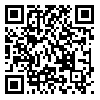Volume 27, Issue 1 (3-2003)
Research in Medicine 2003, 27(1): 41-45 |
Back to browse issues page
Download citation:
BibTeX | RIS | EndNote | Medlars | ProCite | Reference Manager | RefWorks
Send citation to:



BibTeX | RIS | EndNote | Medlars | ProCite | Reference Manager | RefWorks
Send citation to:
Role of citalopram in preventing ouabain-induced toxicity in guinea pig. Research in Medicine 2003; 27 (1) :41-45
URL: http://pejouhesh.sbmu.ac.ir/article-1-180-en.html
URL: http://pejouhesh.sbmu.ac.ir/article-1-180-en.html
Abstract: (15375 Views)
Background: The role of citalopram (a tricyclic antidepressant of SSRI group) on ouabain-induced arrhythmia in guinea pig was well established.
Materials and methods: Thirty-two guinea pigs were randomly assigned in any of the four groups citalopram, ouabain, citalopram+ouabain, and control. The Na, K, and Ca concentrations were measured using atomic absorption technique.
Results: Citalopram could significantly reduce the contractility and pulse rate. Ouabain-induced arrhythmia occurred after 4.5 minutes and ouabia-induced asystole and toxicity was revealed after 20 minutes, however, previous administration of citalopram (8g/ml) prolonged the time of arrhythmia to 9 minutes and the atria were alive till the 20th minute (p<0.05, and p<0.001, respectively). Ouabain administration was accompanied with increased Na concentration, however, K and Ca concentrations have not significantly changed. Citalopram has changed the K concentration (p<0.05).
Conclusion: Citalopram has a direct negative inotropic effect on guinea pig atria. This may be explained through an inhibitory effect on Na and K channels or potassium hyperpolarization. Meanwhile, citalopram prevent ouabain-induced arrhythmia and toxicity. This activity could be due to cell membrane stabilization and cessation of ionic changes.
Type of Study: General |
Subject:
Interdisciplinary (Educational Management, Educational research, Statistics, Medical education
Received: 2003/01/1 | Published: 2003/03/15
Received: 2003/01/1 | Published: 2003/03/15
| Rights and permissions | |
 |
This work is licensed under a Creative Commons Attribution-NonCommercial 4.0 International License. |




